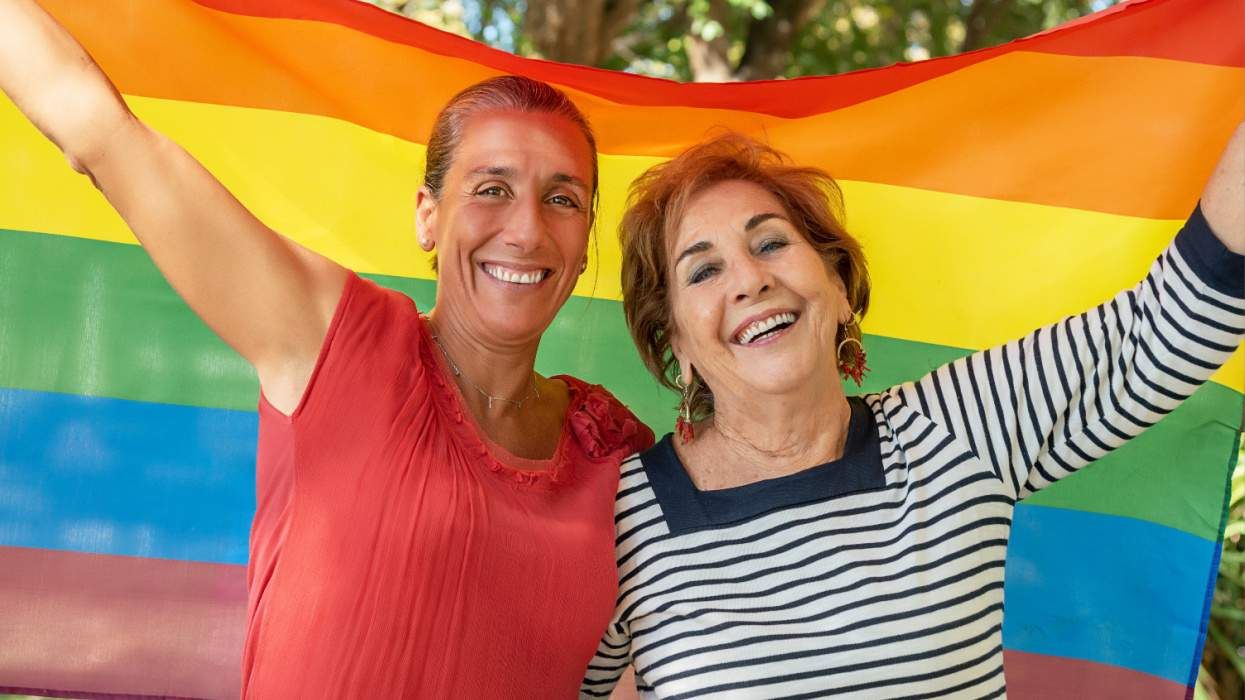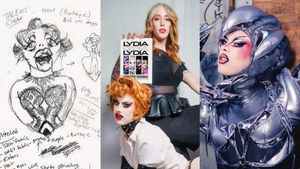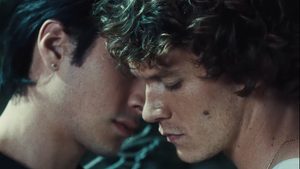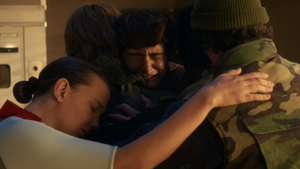Updated: June 6, 2017, to add last name of Rebekah Bruesehoff, the very cool 10-year-old in the protest photo above.
Americans like the idea of overnight successes. We think that if we didn't know about someone (or something) until today it probably didn't exist. We love our celebrities, but few things hold our attention for long. Maybe that's why Americans keep forgetting about trans people.
When Keeping up With the Kardashians premiered, some critics derided the family for being famous for nothing beyond being famous, claiming that celebrities of "the past" gained fame because of what they did, not for who they were. But the truth is, this kind of celebrity isn't a 21st-century invention. It's been around at least since the 1950s, when one of the world's first celebrities to gain international fame was a trans woman named Christine Jorgensen.

While Christine Jorgensen (who died in 1989 at 63) was not the first transgender woman to undergo gender-affirming surgery, she is the first to have been widely known to do so.
Indeed, gender-nonconforming people have existed in America long before Christopher Columbus landed on its shores. Many Native American tribes had traditions including two-spirt members. The Old West had its own gender-bending individuals like the cowboy Little Joe Monaghan and other men who turned out to be female-bodied. According to historian Peter Boag's Re-Dressing America's Frontier Past, their stories often captured the attention of early newspapers, which churned out salacious copy for eager readers.
But Jorgensen was once more famous than Marilyn Monroe. Renee Richards later got national press for winning her legal battle to compete as a woman in the 1977 U.S. Open. While trans people occassionally made the rounds on talk shows in the years that followed, for many Americans, trans people were still freak show fodder (in The Silence of the Lambs, Nip/Tuck, and CSI). The Advocate's 2008 story about Thomas Beatie drew international attention for trans men, but the sensationalized "world's first pregnant man" coverage certainly didn't "normalize" trans people in the eyes of the public.
The Advocate had featured trans actress Alexandra Billings on our cover nearly a decade earlier, but it wasn't until 2005 that she became the second out trans woman to play a trans character on television (Romy and Michelle: A New Beginning). By then, the behind-the-scenes work trans women like Calpernia Addams and Andrea James were doing in the entertainment industry finally began paying off as more impactful casting came in 2007, when Hawaiian actress Candis Cayne was chosen to star on the series Dirty Sexy Money.

Four years later, Chaz Bono (pictured above) came out as trans, starred in the documentary Becoming Chaz, and competed on Dancing With the Stars. The fact that Bono was the child of celebrities and had become a skilled spokesperson for the LGBT community over the previous decade (he'd been a lesbian activist) made him a well-spoken trans diplomat. Now he's enjoying an expanding acting career, appearing on hit shows like American Horror Story.
Matrix director Lana Wachowski grabbed worldwide attention in 2012, becoming the first major Hollywood director to come out as trans -- and saw no significant impact on her career for doing so. (Her sister Lilly followed in her footsteps a few years later.)
In 2014, #GirlsLikeUs founder Janet Mock's memoir, Redefining Realness, debuted on the New York Times Best Seller list (her follow-up, Surpassing Certainty, comes out this June). That same year, Transparent -- a series that has hired more trans people (behind the camera and in front of it) than any other in the history of television -- premiered.

Above: Janet Mock
It was actress Laverne Cox who dominated TV that year, with her Emmy-nominated starring role on the hit show Orange Is the New Black. And she became the first trans person featured on the cover of Time magazine, when it declared that we had reached a "trans tipping point." (For many activists, it's Mock and Cox who shifted the country's consciousness most on trans issues.)
Yet it wasn't until Kardashian star and U.S. Olympian Caitlyn Jenner came out in 2015 -- with a slew of accompanying media coverage only a Kardashian-Jenner could muster, including a Vanity Fair cover, an interview with Diane Sawyer, and her own reality show, I Am Cait-- that Americans seemed to really sit up and take notice that a revolution was happening around them. Jenner has certainly increased visibility for trans people -- and has helped bring attention to rising stars like the irrepressible Chandi Moore, author Jenny Boylan, and actress Jen Richards (later cast in a reccurring role on Nashville), and elevated the work of gender pioneer Kate Bornstein.
But one also can't understate the extreme privilege that Jenner has as a rich white woman with access to the best surgeons and finest fashions -- and how sharply that contrasts with the lives of most trans women, who studies (like 2015's Paying an Unfair Price: The Financial Penalty for Being Transgender in America) show continue to face extreme discrimination that pushes them into poverty, ill health, and early death.

There's also no denying that Jenner's efforts to promote trans rights are just the tip of the iceberg, which is being held out of the icy water on the backs of thousands of other trans people -- the majority of whom were women of color -- who came before. Trans people have been fighting for their rights in this country as long as gays, lesbians, and bisexuals. In fact, many of the pivotal moments in the LGBT rights movement were brought to us courtesy of trans women like Miss Major Griffin-Gracy (pictured above), Sylvia Rivera, and Marsha P. Johnson -- three gender revolutionaries of color who helped lead the Stonewall riots. They defined intersectional before the word came into use, "Everyone was involved with the women's movement, the peace movement, the Civil Rights movement," Rivera recalled in a 1998 interview for Workers World.
These trans pioneers are finally getting the attention they deserve in two new documentaries. The first is The Death and Life of Marsha P. Johnson, a film by gay director David France (How to Survive a Plague) that wowed at the Tribeca Flm Festival. It documents the activism of Rivera and Johnson, who in 1970 cofounded STAR (Street Transvestite Action Revolutionaries) to provide housing and support for trans women of color.
(RELATED: Kat Blaque Cover Interview)
The film also investigates Johnson's suspicious death in 1992, all the more relevant today as trans women of color face escalating violence. Since 1998, the community has held an annual vigil -- Trans Day of Remembrance (founded by Gwendolyn Ann Smith after Rita Hester's death) -- drawing attention to those murdered in the previous 12 months.
While The Death is introducing early trans activists to a mainstream audience, the documentary Major! is being pitched as "a roadmap for liberation" for a new generation of queer and trans activists. (Filmmaker Annalise Ophelian even offers free screenings to social justice organizations.)
(RELATED: Connor Franta Cover Interview)
In the 48 years since Stonewall, Major has never dropped the baton, but other trans activists -- like Asian-Americans Cecilia Chung and Pauline Park -- have certainly helped further the fight for trans rights. And a cadre of trans lawyers like Shannon Minter, Kylar W. Broadus, Jillian T. Weiss, and Paula Neira have taken on a variety of issues, including name changes, custody cases, bathroom access, and discrimination lawsuits. Another early LGBT activist, Phyllis Randolph Frye, went on to become the nation's first out transgender judge.
But now the torch for trans visibility has been handed over to actresses like Ivory Aquino (When We Rise), athletes like pro hockey player Harrison Browne, and YouTube celebrities like Gigi Gorgeous.
(RELATED: Gigi Gorgeous Cover Interview)
The new gender vanguard rises on the shoulders of philanthropist Reed Erikson, who supported early trans medical research and Joan Rough-garden, who challenged evolutionary biology orthodoxy with Evolution's Rainbow: Diversity, Gender, and Sexuality in Nature and People.
For every hot young trans model like Leith Ashley, Aydian Dowling (who almost landed the cover of Men's Health), Hari Nef, and Geena Rocero, there are the relatively stuffy academics like Paisley Currah (whose forthcoming book Not the United States of Sex looks at contradictions in legal definitions of sex and transgender politics) and Susan Stryker (who established the study of trans history and pushed the Obama administration to preserve cultural sites like the Stonewall Inn).
(RELATED PHOTOS: Cover Photo Shoot)
For every trans activist who has just joined the resistance, decided to run for office, or lobby against bathroom bills, there are trans politicians who have served as mayors (like Stu Rasmussen) or worked on Capitol Hill -- like Diego Sanchez, the first out trans congressional staffer (who worked for Barney Frank), Amanda Simpson (the first out trans person appointed to a role within a presidential administration), and cyber security expert Amelie Koran (who works in the Department of Health and Human Services).
Rebekah Bruesehoff, the 10-year-old daughter of a Lutheran pastor, shows the future of trans rights in America. Her photo (at top of page) went viral after she was spotted with her protest sign, "I'm the scary transgender person the media warned you about."
Bruesehoff and her peers are growing up in a world that's increasingly making room for them -- even if that's causing its own political backlash. And their ability to live authentic and empowered lives has less to do with the whims of the latest politician and more on the legacy of work that others have put in laying the groundwork to support their dreams. Forgotten or not, trans Americans have always been here, and we aren't going away.
Janet Mock and Miss Major Griffin-Gracy (pictured above) were shot by photographer/filmmaker Timothy Greenfield-Sanders. Known for his strikingly intimate portraits of world leaders and major cultural figures, from Presidents to porn stars, artists to Oscar winners, Greenfield-Sanders' work defines a certain cultural photographic canon of our time. Greenfield-Sanders has produced and directed thirteen feature documentaries, winning a Grammy Award for his 1998 film Lou Reed: Rock and Roll Heart and a NAACP Spirit Award in 2009 for The Black List: Volume 1. In 2015 he was awarded the Legend Award by Pratt Institute. His latest film, The Trans List, is up for a GLAAD media award for Best Documentary.
Rebekah Bruesehoff is photographed by her very supportive mother, Jamie Bruesehoff.
Additional reporting by Christopher Harrity.








































































Charlie Kirk DID say stoning gay people was the 'perfect law' — and these other heinous quotes